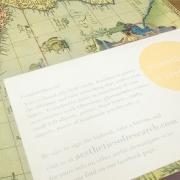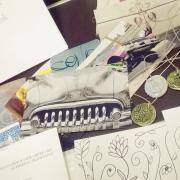Part-geocache, part-hidden exhibit, part-library scavenger hunt, ARTCACHE gives participants an opportunity not only to participate in this interactive exhibit, but also to have some fun, learn more about the library, and brush up on their research and problem-solving skills.
The search takes participants through highlights of Chicago art, culture, and history (as well as all five floors of the Columbia College Library) and eventually leads them to the hidden cache, a hidden-in-plain-sight collection of contributed artwork. For both artists and non-artists, the cache offers participants an opportunity to sign the logbook, to peruse the items within the cache and take a souvenir piece — as well as contribute their own small piece to the collection, if desired.
Advanced Planning
To prepare your cache, you will need:
Initial box/container
This container marks the start of the hunt, and so should be able to sit in the stacks among materials unnoticed unless you are looking for it. Size will also determine/be determined by the contents. Smaller boxes may work well for smaller items (miniatures, jewelry). Larger boxes can accommodate larger pieces (small paintings, sculptures, prints.) Feel free to decorate/design your box with any theme you might be using or camouflage to hide it among the shelves.
Initial box contents
To fill the box, aim for small art/craft items that can be exchanged with other art/craft items by participants. In this way, the “exhibit” and box offerings will change as more people contribute. Good options are small paintings, artist trading cards, zines, small book arts projects, broadsides, handmade jewelry, small sculptures, mixed media pieces, prints, photographs, matchbox assemblages. These can be collected from individual contributing artists or worked on as part of a group project in the library or a classroom.
Logbook and other takeaways
Notebooks or small journals are perfect logbooks to collect signatures, email addresses, small sketches or drawings. You may also wish to have other items — e.g., pinback buttons, bookmarks, keychains, promo pens — for participants to collect along with their art pieces. Non-artists can also participate by just signing the logbook and taking one of the souvenir items.
Clues, puzzles, instructions for finding the box
Clue mapping can be as simple or as complex as you wish it to be, and can involve all sorts of stops along the map, including call number locations on the shelf, physical points of interest in the library, puzzles, games and/or interacting with library service points and staff. You can also choose to focus your instructions and clues on a theme, such as local history, certain genres, a single artist or other special topics. You will also need to determine the length of time your ARTCACHE will last — a week? A month? Longer? How long do you expect the hunt to take for the average audience? Should it be completed in one visit or can it be done over several visits? Where will the hunt start — a service desk or another location in the library? Does the hunt involve interacting with library staff and resources? How is this best accomplished? How detailed do you want your initial instructions to be?
Marketing
Depending on your library, your target audience may be students, the public and/or other artists, so your marketing should be geared toward those groups via posters, web promotion, print media, fliers and/or social media. It also helps to have a graphic element that is identifiable, such as a logo or other visual benchmark for participants to look for as they maneuver the course.
Budgeting
This program is doable on little or no funding, depending on execution. The container can be something reused or upcycled. Initial box contents can be donated or created in-house. Any funding can be used for marketing purposes, takeaways or materials.
Day-of-event Activity
Once you have determined the start date and length of time that the ARTCACHE will run, fill and place your box in the start location and place all clues in their respective spots on the start date.
Program Execution
Our total participants is estimated at close to 30. (We had 25 signatures in our logbook, but not all left or took items, and some left items, but did not sign the logbook.) We had to clarify one of our early clues based on some feedback to ease the course, but met no other challenges. We were hoping to have at least 20 people come through, so we exceeded that number.
Advice
The most difficult aspect of formulating ARTCACHE was coming up with a clue map. We ran a trial over the summer that was very complex with several puzzles and red herrings, but our student staff (who agreed to be our guinea pigs) thought that it was a little too difficult and time-intensive, and therefore liable to make them abandon ship halfway in. So we adjusted the map and clues based on their feedback. Be mindful of audience to create a challenging — but not impossible — experience for your participants.
Supporting Materials
- Feedback (Coming Soon!)
- Programming Librarian Facebook Group




